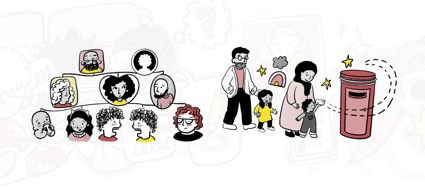The Bright Spots programme supports local authorities to listen to their children in care and care leavers about the things that are important to them.
The 10,000 voices report highlights what children in care have said about what is important to them and their wellbeing. It has been produced by Professor Julie Selwyn and Coram Voice as part of the Bright Spots programme, and summarises learning from 9,426 responses over five years from children in care aged four to 18.
Launched alongside the report is a resource bank with practice examples from local authorities who made improvements based on what young people told them through Bright Spots surveys. There are ideas related to promoting positive body image, friendships, pets and making sure children are well informed about decisions.
Resources to support the wellbeing of children in care and care leavers
Bright Spots and Research in Practice have worked together to produce related resources for practitioners and strategic leads who are supporting children in care, including:
The briefing provides key messages from the Bright Spots programme, practice examples and reflective questions to help strategic leads and practitioners think about how they might use the evidence and be involved in the programme in the future.
This recorded webinar shares key learning from the Bright Spots programme so that professionals can better support children in care and care leavers.
What did the 10,000 voices report find?
The Bright Spots findings show that many children in care feel well supported. 83% of children and young people feel that life is getting better and, compared with the general population, a larger percentage of children in care felt safe where they lived, liked school and felt the adults they lived with took an interest in their education.
‘I feel healthy, safe, and supported. From what my life was like three years ago, it is now much, much better.’

However, some children still struggle and there are areas where they do worse than children and young people in the general population. By teenage years, one in six reported low overall wellbeing. A larger percentage of young people also rated their life satisfaction, happiness and feeling that the things they did in life were worthwhile as ‘low’. Compared to the general population, fewer young people in care had a good friend or talked to the adults they lived with about things that mattered to them.
‘I just keep being moved around. I have moved I think seven times in the last six months. This makes me confused and scared. It has been dark and scary when I move, and I am told where, as we drive. I never meet the people beforehand and my things take time to catch up with me.’
All the things that we ask about in the ‘Your Life Your Care’ survey are important to children’s wellbeing. But the analysis showed that some things were more strongly associated with wellbeing. Based on this, the report recommends that to make life good for children in care, they need:
- Carers who they trust and who are sensitive to their feelings.
- Somewhere to live where they feel safe and settled.
- Social workers who don’t change, are easy to contact, and they trust.
- Opportunities to build and keep relationships with the people who are important to them.
- Involvement in and information about their care and their families.
- Opportunities to be trusted and practice life skills as they get older.
- Fun in their free time and chances to do similar things to their friends.
The diagram below illustrates the factors associated with wellbeing by children in care.

Importantly, the findings clearly showed the importance of not treating all children in care as if they are the same. Whilst they had things in common, the challenges that children and young people faced also differed with age, sex, placement type, and ethnicity. For example, girls reported lower wellbeing than boys, as did young people living in residential care or supported accommodation.
A greater proportion of young people in residential care and living ‘somewhere else’ (mostly supported accommodation, prison or hospital) reported lower wellbeing, for example not feeling safe where they lived and not having a trusted adult. This short film about the 10,000 voices report will tell you more.
The Bright Spots programme continues to work with local authorities across the country to capture children and young people’s voices and respond to what they say at the local level.
Contact
To find out more, contact brightspots@coramvoice.org.uk.



